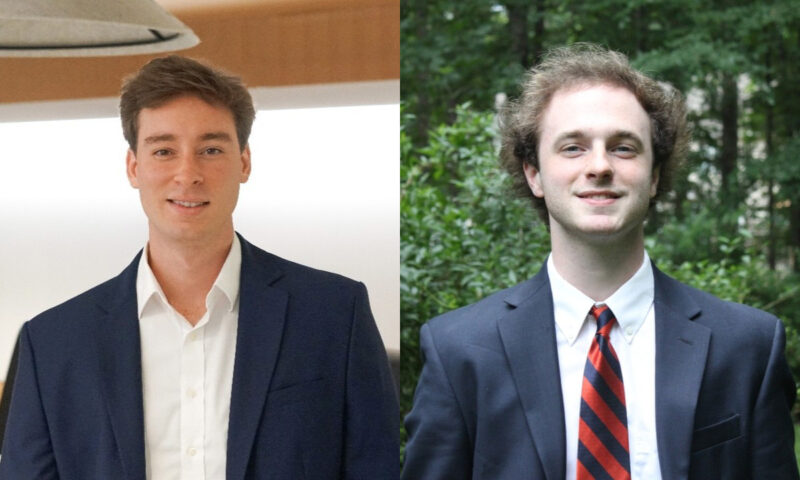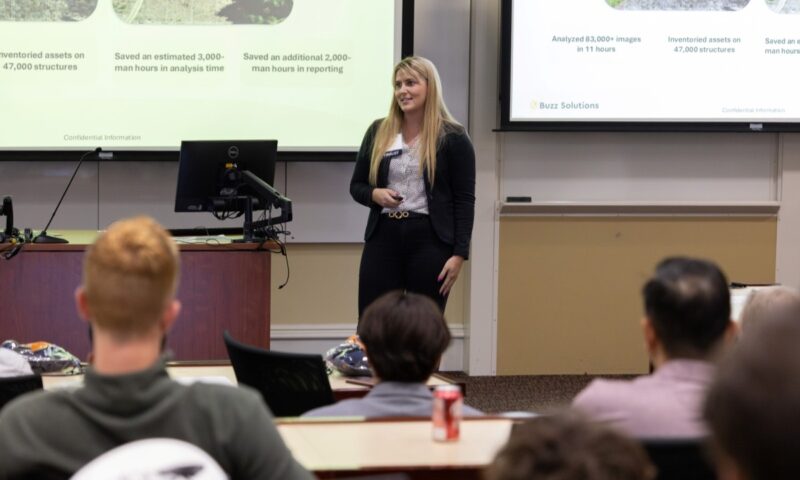
Top row: Zander Geronimos, Coby Lefkowitz. Bottom row: Courtney Nickels
From the launch of the new Center of Real Estate and the Built Environment to the creation of the Commerce School-hosted Real Estate Minor, the subject is getting its due attention across the University. Zander Geronimos (McIntire ’14), founder of the UVA Alumni in Real Estate, says the recent initiatives have invigorated many alumni working in the multifaceted industry to join the group.
A University guest lecturer who serves as Head of Strategic Partnerships and Business Development for MetaProp, Geronimos says what began as a one-off get-together among a few interested people in 2017 has now swelled to count roughly 1,000 active Hoo alumni in its numbers across the globe. And according to the group’s LinkedIn page, that total has been steadily rising as new members join their ranks every day. That steady success is the product of a committed and concerted effort on Geronimos’s part.
About seven years ago, he realized that there was a need for a real estate group in which UVA alumni could connect, share ideas, discuss industry issues from a variety of different disciplines, and develop their professional networks. It all started with a roundtable lunch.
After working out the details and getting formal approval for the group, invitations to a meeting featuring speakers Bob White (McIntire ’87), Founder and President of Real Capital Analytics, and Ryan Johnson (McIntire ’06), Founder and Principal of AAO Property Group, were quickly accepted, and the event filled up within mere hours. That successful meeting resulted in planning more events such as happy hour development tours that took place on a quarterly basis in New York.
In late 2019, Geronimos undertook a concerted effort to cast a wider net. “Because we had about 300 people at the time, I spent some time organizing a few other meetings in Charlottesville, New York, and Chicago,” he explains. “But then during the pandemic, we invited everyone to get them involved. There’s been a massive network effect.”
Searching on LinkedIn, Geronimos discovered that there were more than 5,000 alumni working in various aspects of real estate and promptly sought to encourage them into the fold through engaging programming centered on different areas of the subject that they were already professionally involved in.
“It’s been interesting to see the growth of a real network that we can leverage by sharing deals, getting jobs, mentoring students, or just connecting,” he says. “They are out there, and we’re just beginning to tap into it.”
In the spirit of that first roundtable lunch and its aim of sharing ideas, we caught up with Geronimos; Coby Lefkowitz (Architecture ’18), Principal and Co-Founder at Backyard, as well as the founder of the Virginia Undergraduate Real Estate Club (VUREC) student org; and Courtney Nickels (McIntire ’08), Senior Vice President at Artemis Real Estate Partners, to discuss recent significant shifts in each of their respective corners of the industry and to capture their views on the many possible futures of real estate.
Since you began your career, what has been the most notable change in real estate, and how has it impacted your work?
Courtney Nickels: I began my career in real estate in 2008, just after the start of the Great Financial Crisis, and the overall market shift has been quite dramatic in less than 15 years. I was interviewing for jobs as the real estate bubble dominated headlines, and admittedly as a fourth-year, I did not fully grasp the magnitude of what was unfolding. Now I consider myself very fortunate to have actually landed a real estate job out of college during that time period (thanks to McIntire!).
I have since spent my entire career to date in real estate acquisitions for private equity investment firms. The start of my career was during a time with a damaged economy, fundraising uncertainty, and real estate market distress, which certainly impacted the way I was trained in real estate and some of my subsequent job changes. As the market recovered, it led to new opportunities in alternative real estate investments. The expansion of the healthcare industry and increased private equity investment in the healthcare asset class made it possible for me to focus on this important sector for the most recent 10-plus years of my career. Healthcare continues to be a fragmented investment industry and is expected to continue a tremendous growth trajectory, with which I am fortunate to align my career. I didn’t anticipate my path leading in this direction when I started my career in real estate.
Coby Lefkowitz: The most notable change has to be the rise of remote work. While there were some companies that offered it as an option, and some people who were able to work independently in a place of their choosing, it was limited for traditional office jobs. But that’s since changed in the last two years, and it’s never going back. As I see it, this is a really good thing. The decentralization of work allows people to live wherever they want, untethering the historic bounds of occupation and place. This is potentially the greatest change in how humans have worked in millennia, but certainly since the beginning of industrialization. It’s been incredibly liberating for me personally. I’ve gotten to spend more time with my family, work flexibly in different places around the country, and broaden my perspective on what the future of the built environment will look like.
It’s empowered me to lean into the idealism I’ve long harbored for how to create better places to live, work, and experience life. In breaking free from the traditional constraints of what real estate can look like or mean, we can reimagine places in ways that speak to our collective higher aspirations. Instead of underwriting central business district office buildings, neighborhood power centers, or homogenous tract housing, we can plan for truly comprehensive communities that place individuals above where they work, how they get to work, and the commoditized interstitial spaces we occupy throughout the day.
Zander Geronimos: Maybe this is just the bias of my perspective, but for the proptech world specifically, all of a sudden, we became less of a “nice-to-have” in the last five years.
Bob White was one of the first to use data science—he was really leading the charge to lay the foundation; he’s considered the godfather of proptech. And Bob is the one who advised me to check out a couple of interesting companies that were doing what eventually would come to be called proptech. That’s how I got into leasing and asset management platform VTS, where I worked for four-plus years. But at that point, no one was taking any of it seriously; no one would pick up our calls.
When I first started working at VTS, we were focused on commercial leasing with a traditional way of engaging with our leasing reps via a biweekly call and with a spreadsheet. Now, it’s become a digital-first process to keep the front office, accounting, asset management, marketing, and leasing teams all on the same page. A few hundred companies in 2015 were focusing on proptech, and now we’re tracking over 15,000 companies globally.
What do you see as the most important issue in the industry? In what ways does that issue present new opportunities?
Coby Lefkowitz: The most important issue is how we build real estate—both geographically and compositionally. We need to broaden our understanding of how we interact with the world, namely that we don’t need to live in homogenous zones that segregate by use and force a dependency on private vehicles to get anywhere. This has dire consequences for the environment, the fiscal state of our communities, our physical health, and mental health through impacting social connections and the psychology of how we perceive space. We can no longer build sprawling suburbs 30 miles from city centers, where one has to drive 15 minutes to go to a large big box store to do their daily errands.
For nearly a century, our underlying development patterns (driven by zoning, industry standards, and lending environment) have effectively only allowed for the development of one kind of place. While a majority of Americans want to live in more walkable communities, only 8% do. There’s a massive supply-demand imbalance to live in the most vibrant, walkable places. In most cities, these tend to be the most expensive areas to live in. The market is signaling loud and clear that these are the types of places people want to live in. This is disproportionately true for younger generations. As such, there is the potential to create beautiful, interconnected, vibrant, and walkable places that house millions of people. This is the largest unmet demand in real estate today.
Zander Geronimos: The topic most talked about as of late has been hitting net neutral. A lot of local, municipal, and national government requirements are saying real estate has contributed 30% of the carbon or 40% in some cases. And that is a major issue for owners.
And a lot of what I’ve seen—and where it’s an issue—is the approach of carbon-offset programs, which don’t necessarily solve the problem at the actual asset. Some say they’re going to buy a forest to cover their carbon and other gases that can contribute to toxicity in the air, and that overall requirement is giving rise to a lot of sustainability funds and companies. But at this point, it’s all about really understanding at the core asset level what the data is telling you and what your actual energy and carbon impact is. Most firms have meters that are from the late ’60s or ’70s and haven’t been upgraded or audited. So that number of 30% is actually much more of an extrapolation without knowing how much energy usage has actually gone into a given asset.
Opportunities in this area have made some pretty exciting ideas about how we can get neutral and more sustainable buildings using existing materials and without having to have a major impact on the environment. One concerns the CO2 emissions at the production site of cement. They found a new way of harnessing hydrogen to produce cement at a net neutral capacity [through methane pyrolysis]. Another idea is bio-cement or bio-mix from Prometheus Materials out of the University of Colorado, which uses algae to breathe in the CO2 emissions that concrete would normally exude.
Courtney Nickels: As we saw in 2008, the real estate industry remains increasingly vulnerable to rapid change and disruption. In recent years, the growth and buying power of non-traded REITs, technological advances continually shifting the work and workforce, and most recently, the enormous impact of COVID-19 have all materially and quickly impacted the overall industry and individual sectors. In particular, COVID has certainly shined a spotlight on how radically and quickly things can change: Office utilization plummeted and remains low, consumer behaviors changed and further fueled industrial growth, lifestyles were reshaped and housing continues to peak, and people were reminded how critical healthcare truly is. As a real estate investor, I believe it will be important to keep this in mind and be continually adapting with and anticipating change in order to find new investment opportunities, while also maintaining a focus on long-term value potential.
What functional aspect of real estate seems most ripe for disruption? Where might the presence of a new approach help the industry to make strides?
Coby Lefkowitz: I think the regulatory side of building is the most ripe for innovation, though perhaps not in ways many would associate with traditional disruption. As any real estate practitioner will know, a grand vision is only as good as what the city will allow you to build based on underlying zoning codes. This informs what lenders feel comfortable financing and how communities are composed. If we want more affordable places to live; more inspiring places to work; and more fun places to eat, drink, hang out, and experience, we need to liberate the regulatory state of our cities so that they can better respond to our many and varied needs. This is very difficult to do on a municipality-by-municipality basis, and holds very little monetary reward for solving. But there are state governments around the country that are setting progressive agendas for counties and cities to follow.
Courtney Nickels: Due to the ongoing labor shortage—and out of sheer necessity—I think there will be innovators who form new solutions to the underlying labor challenges in just about every sector of real estate. In my industry of focus, there must be continual innovations in staffing, care, and case management to support the exponentially growing healthcare needs that will come with the aging of the baby boomer generation, increasing life expectancy, and other demand drivers. Since labor is generally the most “expensive” line item in many real estate sectors and is currently such a hot topic, new approaches to improving labor efficiencies would support the overall industry and allow for a more sustainable labor supply.
Zander Geronimos: It’s good question. Definitely the material side, which is going through early experimentation. And I think offices are going to go through their own revolution to make it more interesting for tenants. Offices are still going over this question of making the office more attractive and flexible at scale because the majority of office space was not co-working friendly. That’s the challenge, and it will be interesting to see how office owners respond or evolve in the next few years as flexible working and distributed working continue.
Related to the previous question, what do you see as the largest roadblocks to progress in that area?
Courtney Nickels: I can hardly think of a challenge that will be more difficult to solve than labor. Each sector will have its own specific labor issues and opportunities, and any solutions will require meaningful and continual adaptation. For most jobs, I think technological innovation is critical, but it will be extremely difficult to completely replicate or replace the human component of healthcare with machines.
Coby Lefkowitz: Vested interests. Despite the undeniable empirical benefits of more mixed-use, walkable, healthier, and sustainable places, there are many groups of people who perceive these changes as a threat. There are homeowners who fear for their home values decreasing with more intense land-use patterns (though this isn’t borne out by data; in fact, it’s the opposite), trade groups whose constituents would stand to suffer with a change in the status quo, and community groups who, sometimes with merit, are concerned with what their neighborhood will look and feel like after such proposed changes.
The solution is twofold. First, to mollify concerns by targeting each group directly. This will look different to different people, so it’s difficult to propose sweeping suggestions here, but I’ll say it’s important to hear and consider what each group needs. Ultimately, these needs must be subservient to the second part of the solution—addressing broader community needs. If there’s a desperate shortage of affordable housing, or nowhere that small businesses can set up shop, vested interests must give way to those community needs, which can be unlocked by both private and public developers. While a neighborhood might fear what a gradual upzoning to allow for apartments might mean, if that community is so expensive that people are spending a third or half of their income towards housing, there must be new supply introduced to reduce this pricing pressure. It’s unacceptable to continue with a status quo that impoverishes people because one small group is fearful of their property value reducing—which, again, actually increases through upzoning.
Zander Geronimos: The biggest roadblocks to transforming office or some multifamily housing in high-density areas is the expectation that people are going to demand these spaces and we don’t have to necessarily transform them. So it’s still conviction of the status quo.
And perhaps even the residential tenants who buy back into it. Usually, it’s a lot of the old guard. It is going to prohibit a lot of the creativity. However, I would say that the owners, operators, and even the occupiers who embrace it are going to be way more interested, be more competitive, and have a higher ability to attract and retain talent and occupancy levels because they’re more creative in their “amenitization” of the space. Because, then all of a sudden, these assets are just classified differently, and they are going to be trading at a higher rate. They’re not going to see a return now, but in the long term, like in the next 10-15 years. It will take that foresight to take a loss in the next two years, so people will have to have that long-term vision. It goes back to the first question.
It’s the classic crossing-the-chasm situation. The first movers and the vision of what is creative, interesting, exciting, and innovative in real estate have passed beyond the first people willing to test and experiment. Now it’s at the middle stage, when everyone who would typically shy away from taking these risks is embracing technology and digital transformation.


